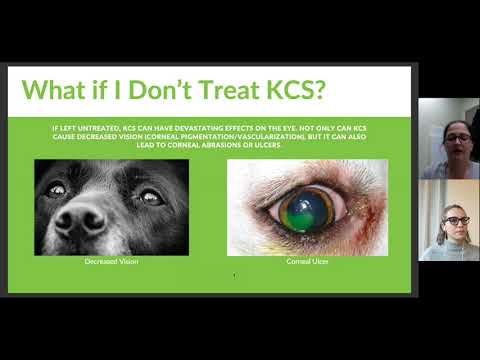
Katie Whitford discusses cataracts and post-operative complications in this RACE approved webinar. She covers pre-surgery care, cataract surgery options, and post-operative complications, emphasizing the importance of evaluating patients for conditions like keratoconjunctivitis sicca (KCS) before surgery. She also explains the causes, diagnosis, and treatment of KCS, as well as the steps involved in cataract surgery, including the use of intraocular lenses.
0:00 - Understanding Cataracts and Post-Op Complications with Katie Whitford
- Webinar introduction and speaker background
- Definition and causes of cataracts
- Factors affecting cataract surgery candidacy
4:04 - Evaluation and Management of Keratoconjunctivitis Sicca in Dogs and Cats
- KCS can cause scarring, vascularization, and pigment, leading to inflammation during cataract surgery.
- Evaluation for KCS involves measuring tear production and checking intraocular pressure to rule out glaucoma or uveitis.
- KCS is defined by reduced tear production, mainly seen in dogs, and can be evaluated through tear film layers.
- Tears are important for maintaining corneal health and clarity, acting as a barrier to pathogens and supporting vision.
- Common causes of KCS include drug-induced, surgical, infectious, congenital, and neurogenic factors.
8:07 - Diagnosing and Treating Keratoconjunctivitis Sicca (KCS) in Dogs
- Common dog breeds prone to KCS include pugs, yorkshire terriers, shitzus, and cocker spaniels.
- Symptoms of KCS in dogs include squinting, excessive tearing, dry and dull corneal surface, and increased risk of eye infections.
- Diagnosis of KCS can be done using the Schirmer tear test or the newer eye tear test, which is more suitable for wiggly or uncooperative pets.
- Untreated KCS in dogs can lead to chronic keratitis, corneal pigment, ulcerations, and corneal perforations, causing severe eye damage.
12:09 - Treatment Options for Keratoconjunctivitis Sicca (KCS) and Cataracts in Pets
- KCS can lead to blindness if left untreated due to lack of hydration in the cornea.
- Treatment for KCS involves lubricating the cornea and stimulating tear production.
- Cataracts can cause vision loss and have various causes including genetics, trauma, and age.
- Cataract surgery involves multiple steps, starting with making an incision.
16:12 - Surgical Procedure for Cataract Surgery: Incision, Suturing, and Viscoelastic Injection
- Making the incision into the cornea at the limbus with different sizes of keratome or crystal blade.
- Using absorbable sutures to close the incision and injecting viscoelastic to protect the cornea and aid visualization.
- Injecting mono blue to stain the anterior lens capsule for easier performance of capsular hexis during cataract surgery.
20:15 - Cataract Surgery Procedure and Intraocular Lens Options
- The process of breaking up and vacuuming out the opaque lens material during cataract surgery.
- Criteria for placing an intraocular lens and the benefits it provides to the patient.
- Different options for intraocular lenses and the process of inserting and positioning them.
- The removal of viscoelastic material from the eye and the closure of the incision after surgery.
24:19 - Preventing Post-operative Infection and Dry Eye in Cataract Surgery
- Ophthalmologists prefer monofilament option to prevent post-operative infection.
- Dry eye must be well controlled before cataract surgery to prevent delayed healing.
- Diabetic patients are at higher risk for developing dry eye post-operatively.